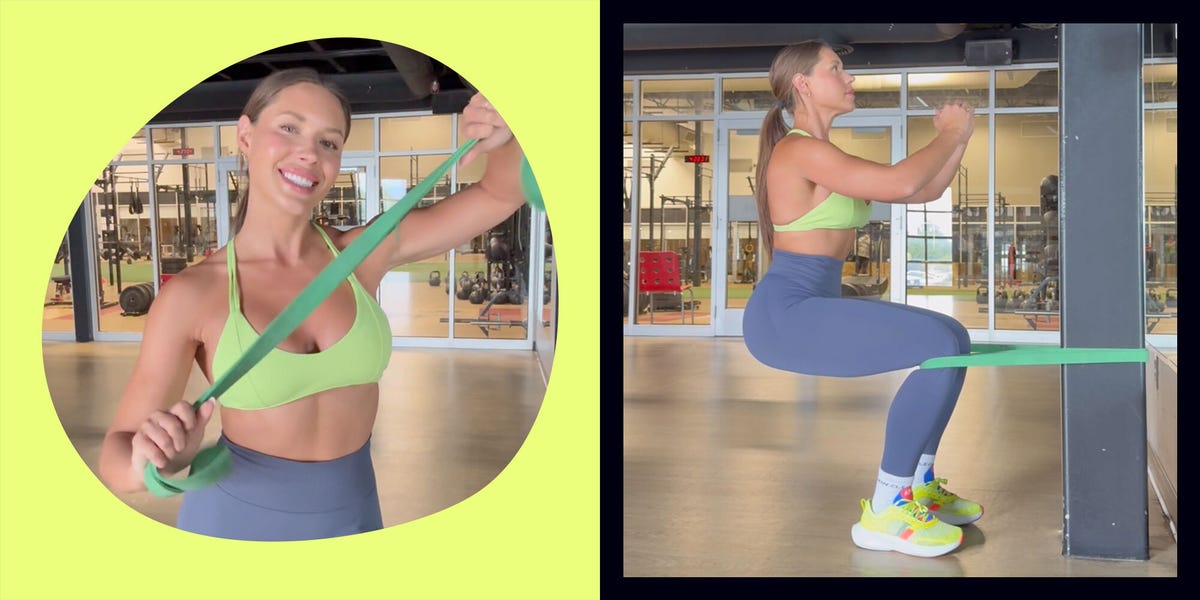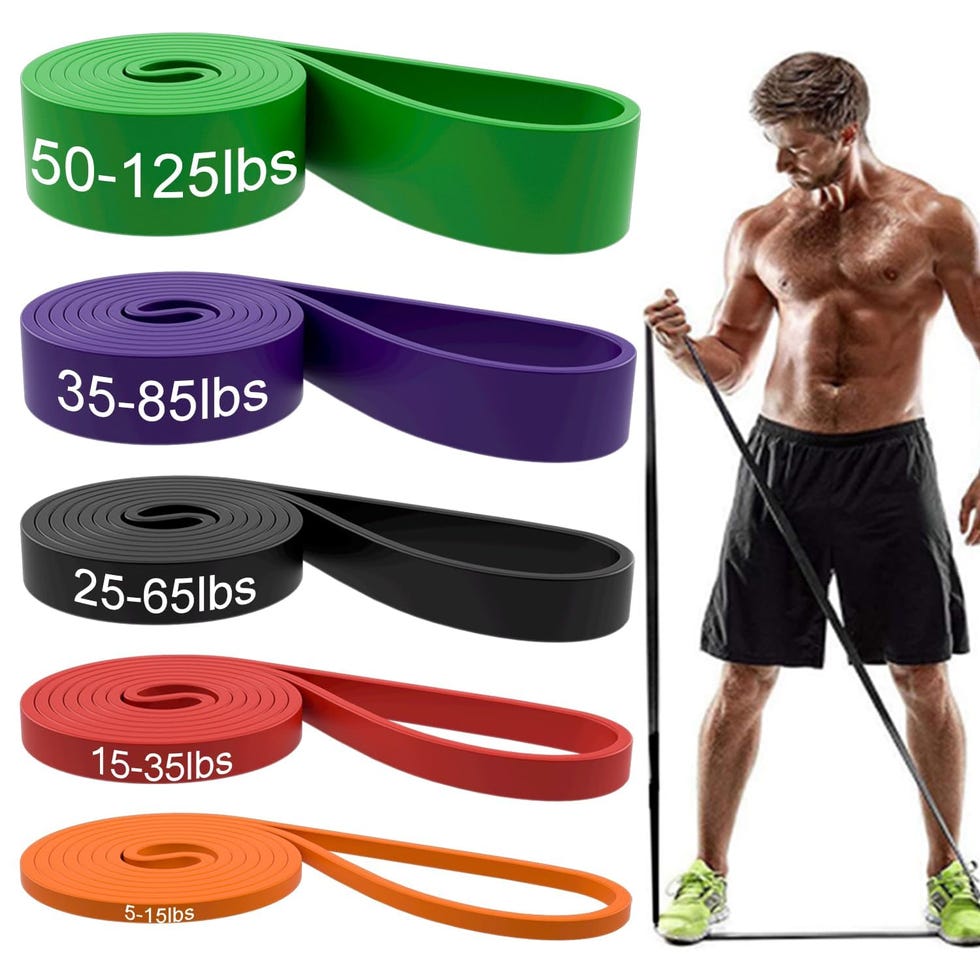Squats are one of the major compound lifts, and countless variations—back squats, goblet squats, split squats, front squats—help target particular muscles in your lower body. A relatively under-the-radar variation (until recently) is the Spanish squat, which uses a resistance band or strap anchored behind the knees for support.
Spanish squats have been all the rage lately, especially with trainers and physiotherapists. “The Spanish squat is having a bit of a moment, and I totally get why,” says Utah-based personal trainer Kelsey Wells. It’s a controlled, low-impact, quad-focused compound exercise that’s also gentle on the knees, she says.
That knee-friendly reputation is exactly what makes this move stand out. Spanish squats strengthen key muscles like the vastus medialis and vastus lateralis—two parts of the quads muscles (front of the thigh) that help stabilize and extend the knee joint—and can even reduce pain and improve function in people dealing with knee issues like patellofemoral pain syndrome, according to research in the International Journal of Sports Physical Therapy.
So, how exactly do you do Spanish squats effectively? Ahead, Wells breaks it down, explaining how they differ from traditional squats, and why this move might be exactly what your knees have been begging for.
Meet the expert: Kelsey Wells, CPT, is a Sweat trainer who created a PWR workout program to help women reach their fitness goals.
How A Spanish Squat Differs From A Regular Squat
A Spanish squat is a lower-body exercise where you squat with your thighs supported by a resistance band anchored behind your knees, helping isolate and strengthen the quads while reducing strain on the knees and hips.
This strap (or band) is what differentiates the Spanish squat from other variations like the traditional squat, which primarily activates the glutes and quads. “This setup shifts your body mechanics—it keeps your torso more upright and places a stronger emphasis on the quads,” says Wells.
So what does this mean? There’s less load on the patellofemoral joint (the joint between your kneecap and thigh bone) and less stress on the patellar tendon, making the exercise more friendly for anyone with knee issues or pain.
Anchoring a band around your knees creates a counterforce that helps stabilize you and ensures you stay in the correct position, Wells says. “It allows you to sit back into the movement while keeping your knees in line with your feet, which reduces stress on the knee joint.”
This setup makes the exercise safer and increases quad engagement. The upright form you can get into with help from the strap reduces force on the knees while targeting your knee extensors—the vastus medialis (VM) and vastus lateralis (VL)—two key parts of the quadriceps muscle group that support your knees, according to research conducted at Staffordshire University.
Benefits Of The Spanish Squat
It turns out, setting up your squats with a band behind your knees has some unique benefits.
- It builds quad strength and power. “Spanish squats are phenomenal for isolating and strengthening the quads,” says Wells. Strengthening your quads with exercises like this helps boost power and overall performance.
- It builds strong, stable knees. Spanish squats target the knee extensors, which are crucial for movements like walking, running, and jumping. Strengthening them improves knee stability, reduces injury risk, and helps prevent other muscles from overcompensating or becoming overloaded, according to research published in the Journal of Propulsion Technology. “When your quads are stronger, they can better support your knees, which can help reduce knee issues and improve overall stability,” says Wells.
- It helps reduce knee pain. If you already have a knee issue like patellar tendinopathy or patellofemoral pain, Spanish squats might help reduce pain, according to research in in BMC Sports Science, Medicine and Rehabilitation, and the International Journal of Sports Physical Therapy. Of course, it’s best to get advice from your healthcare provider before trying Spanish squats or any other knee exercise to manage existing pain.
- It encourages better form and posture. Spanish squats can help encourage an upright torso and reinforce proper postural alignment and muscle engagement, which can train your body to naturally keep better form in other exercises and movement patterns both in the gym and daily life, says Wells. “They can also help address common issues, like letting the knees cave inward,” she says—a common problem (called valgus collapse) many people have during the squat.
- It is accessible and low-impact. “Spanish squats are gentle on the joints while still being highly effective,” Wells says. Plus, they can be done almost anywhere with just a resistance band.
How To Do A Spanish Squat
Wells gives the following instructions:
- For gym setup, secure a thick resistance band or strap around a sturdy anchor point at knee height. At home, use a resistance band looped around a sturdy object, like a heavy piece of furniture.
- Step into band so it sits just behind knees. The band should have enough tension to support you, but not pull you off balance.
- Stand with feet shoulder-width, facing away from anchor, and lean back slightly so band supports knees. Aim for shins to remain vertical, perpendicular with the floor.
- Sit hips back and down, keeping chest upright, until thighs are parallel to floor (or as low as mobility allows).
- Maintain upright torso throughout movement and activate core to support lower back.
- Drive through midfoot and heels to return to standing. That’s 1 rep.
Common Mistakes To Watch Out For
- Letting your knees cave in. Wells warns against letting the knees shift inward. “Focus on knee alignment and use a mirror or video to check form,” she says. It can be helpful to think about pushing your knees out and aiming to keep them lined up over your ankles.
- Sitting too far forward. It might feel like you’re going to fall, but the band will keep you upright as long as it’s anchored properly. Wells gives this pro tip: “Imagine sitting back into a chair to engage your quads fully.” By not sitting back far enough, your shins won’t stay vertical, which is a big part of why this exercise works so well.
- Rushing the movement. Trying to get through the movement too quickly is a problem many people have with all sorts of exercises, but it’s particularly important to slow down during Spanish squats, since most of the benefit comes from holding the position. “Slow and controlled reps are key to reaping the benefits of this movement,” says Wells.
- Placing the band too high or low. Placing the band in the right spot will help you get into the correct form for this move, which is key for its effectiveness. “Keep the band snug behind your knees, not too high or low,” she says.
Who should try the Spanish squat?
Anyone who wants to improve their squat mechanics and strengthen their lower body should give the Spanish squat a try, according to Wells. It’s also great for people who want to train squats but need to use caution due to existing knee issues. “If your goal is to build muscle or strength, the Spanish squat is a great way to isolate the quads without putting too much strain on joints,” says Wells.
Lastly, they’re an ideal move to do regularly for quad strength, according to Wells, “especially those in sports like running, skiing, or surfing that demand powerful quads and stable knees,” she says.
That said, Spanish squats aren’t for everyone. “If you’re dealing with acute knee pain or a recent knee injury, it’s important to consult with a professional before giving Spanish squats a try. I cannot stress this enough,” warns Wells. She also shares that people with limited mobility might find the move challenging initially and should start with simpler exercises like wall sits or bodyweight box squats to build foundational strength.
How To Add Spanish Squats To Your Workout Routine
Spanish squats are deceptively tough—even without extra weight like a dumbbell or kettlebell. While they’re great for prepping your quads for heavier lifts like barbell back squats, warming up beforehand is key. “I am a firm believer that all strength sessions should begin with a warm-up comprised of light cardio and dynamic stretching,” says Wells.
If you’re an experienced lifter, slot Spanish squats into your leg day or push routine as an accessory move. “They’re perfect after your main lifts, like squats or deadlifts,” Wells says. And while this move is a go-to for physical therapists in knee rehab, don’t attempt it for injury recovery unless your healthcare provider gives you the green light—and follow their exact instructions.
Instructions: New to lower-body training or focusing on knee stability? Start with 2 to 3 sets of 12 to 15 reps using just your bodyweight. If you’re adding weight (like a kettlebell), aim for 3 to 4 sets of 6 to 8 reps.
Choosing the right band: Since the resistance band offers counter-support, the lighter the band, the harder the move is. Think of it like an assisted pull-up—the thicker the band, the more help it gives.
Spanish Squat Alternatives
If you’re not quite ready for full-on Spanish squats—no shame. Here are some alternatives:
Wall Sit
Why it rocks: To build strength and work your way to mastering them, Wells recommends Wall sits as “an excellent place to start—they’re a static movement that targets your quads and helps improve knee stability.”
How to:
- Lean your back against a wall and step your feet about a foot or two from the wall, spread shoulder-width apart.
- Slide your back down the wall slowly until your hips and knees form a 90-degree angle.
- Hold this position for 30 to 60 seconds.
Bodyweight Box Squat
Why it rocks: Box squats, where you sit back onto a chair or box, mimic the motion of a squat while giving you some added support, says Wells. The ideal box height is one that helps you maintain good form. For beginners, pick one that lets the thighs be at or slightly above parallel to the floor. As you progress, you can lower the height so long as it’s not so low or unstable that it will tip over.
How to:
- Stand facing away from box/chair with feet shoulder-width and toes pointing slightly outward.
- Place box six to 12 inches away from you so your shins can be vertical or slightly angled forward when you squat.
- Engage core and keep chest up, shoulders back, and spine neutral throughout entire movement. Extend arms forward for counterbalance if needed.
- Hinge at hips and bend knees, keeping them aligned with toes. Point glutes toward the wall behind you without letting lower back curve or hunch.
- Control descent and lower until glutes lightly touch box. Pause for one to two seconds to stop all momentum before driving through feet to stand back up. That’s 1 rep.
Spanish Squat Progressions
If you’ve mastered the Spanish squat and want more challenge, try adding weight, like a dumbbell or kettlebell.
Pick a weight that feels comfortable to hold in a “goblet” position (cradling a single dumbbell or kettlebell close to your chest with both hands, elbows tucked in). If using dumbbells, you can use a single one held with both hands or opt for two bells, one in each hand. It’s best to start with a lighter weight until you know you can maintain proper form before going heavier.
Set up the same way as you would for the bodyweight version, with a band looped around a strong anchor point. You’ve just got some extra gravity to push against, now.
Best Resistance Bands For Spanish Squats
Read the full article here





